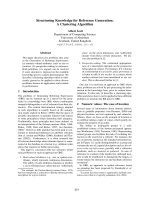Báo cáo khoa học: " Extraneural metastases from cranial meningioma: a case report" pot
Bạn đang xem bản rút gọn của tài liệu. Xem và tải ngay bản đầy đủ của tài liệu tại đây (377.04 KB, 4 trang )
BioMed Central
Page 1 of 4
(page number not for citation purposes)
Radiation Oncology
Open Access
Short report
Extraneural metastases from cranial meningioma: a case report
Mirna Abboud
1
, George Haddad
2
, Mireille Kattar
3
, Ibrahim Aburiziq
3
and
Fady B Geara*
1
Address:
1
Department of radiation Oncology, The American University of Beirut Medical Center, Bliss Street, Beirut, Lebanon,
2
Division of
Neurosurgery, the American University of Beirut Medical Center, Bliss Street, Beirut, Lebanon and
3
Department of Pathology, the American
University of Beirut Medical Center, Bliss Street, Beirut, Lebanon
Email: Mirna Abboud - ; George Haddad - ; Mireille Kattar - ;
Ibrahim Aburiziq - ; Fady B Geara* -
* Corresponding author
Abstract
Extracranial metastases from brain meningiomas is a rare, but well-documented entity. Metastases
occur mostly in the lungs, pleura and liver, but may also affect lymph nodes and bones. We report
here on a patient who was treated for an atypical brain meningioma with multiple surgeries and
multiple sessions of stereotactic radiosurgery with good control of his brain disease. Thirteen years
after diagnosis, he developed bilateral large sacroiliac and abdominal metastases.
Introduction
Meningioma is a common intracranial tumor. Most men-
ingiomas are benign slowly growing tumors that histolog-
ically correspond to World Health Organization (WHO)
grade I. However, atypical (WHO grade II) and anaplastic
(WHO grade III) meningiomas show a more aggressive
biological behavior with a high risk of local recurrence
and a less favorable prognosis. Extracranial dissemination
of meningiomas has been rarely reported. We present here
an unusual case of a patient who was treated for an atypi-
cal brain meningioma originally diagnosed in 1994 and
treated by multiple surgical resections, several courses of
stereotactic radiosurgery and radiotherapy, and a course
of whole-brain radiotherapy with good control of his cra-
nial disease. His disease remained confined to the brain
for thirteen years, after which he developed bilateral large
sacroiliac and abdominal metastases.
Case presentation
The patient is a 45-year-old man who was admitted for the
first time in 1994 at the age of 31 for persistent headache.
Work-up revealed a large left tentorial meningioma. He
had no history of cranial radiation during childhood or
clinical features of neurofibromatosis type I or II. He
underwent gross total surgical resection. Pathologic evalu-
ation, which was recently re-reviewed, showed an atypical
meningioma with the following features: hypercellularity
with sheets of monotonous meningothelial cells display-
ing a prominent mitotic activity with around 4 mitoses
per 10 high power fields. In May of 1997, follow-up brain
MRI revealed a recurrence in the vicinity of the original
tumor bed. Surgery was performed with gross total tumor
removal. Pathologic evaluation again showed meningi-
oma with similar pathologic features. In September 1999,
he developed multiple small tumor recurrences in the
Published: 6 July 2009
Radiation Oncology 2009, 4:20 doi:10.1186/1748-717X-4-20
Received: 25 March 2009
Accepted: 6 July 2009
This article is available from: />© 2009 Abboud et al; licensee BioMed Central Ltd.
This is an Open Access article distributed under the terms of the Creative Commons Attribution License ( />),
which permits unrestricted use, distribution, and reproduction in any medium, provided the original work is properly cited.
Radiation Oncology 2009, 4:20 />Page 2 of 4
(page number not for citation purposes)
parietal, occipital and cerebellar lobes for which he under-
went stereotactic radiosurgery (SRS) with excellent results
on tumor control. In September 2001, the patient devel-
oped additional recurrent lesions in multiple sites in the
infratentorial, retroclival, left optic nerve sheet, and
foramen magnum regions.
He was again treated by stereotactic radiosurgery with
good tumor control defined as a complete disappearance
or progressive decrease in lesion size. In June 2003, he
received further SRS treatment to new cerebellar, premed-
ullary and craniocervical junction lesions. In February
2004, he developed numerous lesions outside previously
treated sites and was given whole brain radiation therapy
(WBRT) of 36 Gy as a palliative therapy because of the
multiplicity and the progression of the brain lesions. Sur-
prisingly many of the small lesions disappeared after
WBRT and the patient remained asymptomatic until
August 2005 when he developed left facial numbness.
Brain MR imaging at that time showed a recurrent lesion
in the left cerebellopontine (CP) angle, an area that was
previously treated by SRS and WBRT. He was given 10 ses-
sions of stereotactic radiotherapy (30 Gy in 10 fractions)
and achieved a good partial response but this lesion grew
back and caused progressive left facial numbness due to
left Vth nerve compression. This was treated by another
craniotomy and surgical resection. Histopathologic exam-
ination showed meningioma with the same pathologic
features and additional elements like the presence of foci
of geographic necrosis and a hemangiopericytomatous
pattern of vasculature (Figure 1A). Mitotic count was now
up to five per ten high power fields and Ki-67 labeling
index was up to 15% (Figure 1B). The tumor was focally
positive for epithelial membrane antigen (EMA) and neg-
ative for CD31 and CD34. The lack of CD34 immunos-
taining excluded the possibility of hemangiopericytoma
or solitary fibrous tumor of the meninges. Occasional
cells were weakly positive for S-100 protein. In July 2007,
follow-up MRI showed tumor progression at the same CP
angle site for which a redo SRS treatment was debated and
finally delivered without significant acute toxicity. Of
note, the question of chemotherapy was raised many
times but the patient refused to receive any systemic ther-
apy.
In November 2007 and because of persistent low back
pain, the patient underwent MRI of the spine and pelvis.
These showed two large masses in the left and right sacro-
iliac and gluteus muscle regions measuring 11 × 9 cm and
8 × 7 cm, respectively, causing bone destruction of the left
sacral wing with extension in the left sacral neural
foramina (Figure 2A). Surgical biopsy was performed and
this revealed metastatic atypical meningioma, with simi-
lar characteristics to its intracranial counterparts. Further
work-up included CT scan of the abdomen which revealed
large bilateral renal metastases (Figure 2B). CT of the chest
was negative. The patient was evaluated by medical oncol-
ogy but declined systemic chemotherapy. Brain MRI
showed no disease progression. He is now receiving palli-
ative care for pain control.
Discussion
Meningioma is a common intracranial tumor that
accounts for 14 to 19% of all primary intracranial neo-
plasms [1]. It is generally a benign tumor, but recurrence
is not uncommon notably for atypical and anaplastic var-
iants. A report by the World Health Organization indi-
cated that 94.3% of meningiomas are benign with a 5-year
recurrence rate of 3% compared to 38% and 78% for atyp-
ical and anaplastic meningiomas, respectively [2]. Distant
metastases from benign meningiomas are extremely rare
and almost all of the reported cases were associated with
a large intracranial tumor [3]. On the other hand, the rate
of distant metastases could reach 5% for atypical and 30%
for anaplastic or malignant meningiomas [4].
Several histologic parameters have been identified as indi-
cators of aggressive behavior and predictors of rapid recur-
rence of meningiomas. These include high cellularity,
mitotic rate, nuclear pleomorphism, presence of foci of
necrosis, and invasion of adjacent structures [5-9]. Other
reported prognostic indicators of tumor recurrence
include change in histologic morphology, malignant
transformation, cellular heterogeneity, and multicentric-
ity [10,11]. In the case presented here, atypical histologic
features such as hypercellularity, relatively increased
mitotic rate (4 mitoses per 10 high power fields), high
proliferation index, and multicentricity were present.
(A) H&E stain on the intracranial specimen resected in 2007 showing high cellularity and sheets of meningothelial cells with a mitotic activity of 4 per 10 high power fields with foci of necrosis (center and lower right)Figure 1
(A) H&E stain on the intracranial specimen resected
in 2007 showing high cellularity and sheets of menin-
gothelial cells with a mitotic activity of 4 per 10 high
power fields with foci of necrosis (center and lower
right). (B) Ki-67 immunostaining with the MIB-1 antibody
showing a labeling index of around 15%.
Radiation Oncology 2009, 4:20 />Page 3 of 4
(page number not for citation purposes)
According to one report, tumors that did metastasize usu-
ally had histologic features consistent with a malignant
phenotype, such as focal necrosis, brain invasion, cellular
pleomorphism, and frequent mitoses [12]. Meningiomas
may disseminate through hematogenous, lymphatic, or
cerebrospinal fluid routes [13]. The most common path-
way of metastasis in meningiomas is considered to be
through the cerebrospinal fluid but this does not explain
extraneural metastases [14-16]. The other mode of meta-
static spread occurs through the passage of tumor cells
into venous channels and spread through the right blood
circulation into the lungs, pleura, and other organs
[17,18]. Isolated hepatic or renal metastasis may occur
through the vertebral (meningorachidian) venous sys-
tem[19]. These vertebral veins have several connections
with the veins of the skull, spinal canal, vertebral column,
and the intercostal veins of the thoracoabdominal wall.
The role of chemotherapy is limited in meningioma; there
are no or limited proven benefit from any systemic ther-
apy and no clear drug or combination regimen that has
given consistent responses.
In order of descending frequency, metastases from menin-
giomas occur in the lungs and pleura, liver, lymph nodes,
and bone [20]. Our patient had metastatic lesions in both
sacroiliac regions and in both kidneys with remarkable
symmetry in these locations. Sacral metastases from
benign intracranial meningiomas are rare occurrences and
could only be found in two reports [21,22]. However,
renal metastases from meningiomas have been reported
more often and constituted in one report 8% of all metas-
tases from intracranial benign and malignant meningi-
omas [23]. We could not find any report with description
of symmetrical features in meningioma metastases.
In conclusion, we report here the case of a 45-year-old
man who developed bilateral sacroiliac and renal metas-
tases from a recurrent intracranial meningioma of atypical
histology 13 years after initial diagnosis.
Consent
Written informed consent was obtained from the patient
for publication of this case report and accompanying
images. A copy of the written consent is available for
review by the Editor-in-Chief of this journal.
Competing interests
The authors declare that they have no competing interests.
Authors' contributions
Authors' contributions: FG participated in paper editing.
MA wrote the manuscript. MK and IAR reviewed the
pathology. GH participated in paper editing. All authors
read and approved the final manuscript.
(A) Axial MRI images showing bilateral sacroiliac heterogeneously enhancing massesFigure 2
(A) Axial MRI images showing bilateral sacroiliac heterogeneously enhancing masses. (B) Abdominal CT scan
showing large bilateral renal metastases.
Publish with BioMed Central and every
scientist can read your work free of charge
"BioMed Central will be the most significant development for
disseminating the results of biomedical research in our lifetime."
Sir Paul Nurse, Cancer Research UK
Your research papers will be:
available free of charge to the entire biomedical community
peer reviewed and published immediately upon acceptance
cited in PubMed and archived on PubMed Central
yours — you keep the copyright
Submit your manuscript here:
/>BioMedcentral
Radiation Oncology 2009, 4:20 />Page 4 of 4
(page number not for citation purposes)
References
1. Wara WM, Sheline GE, Newman H, Townsend JJ, Boldrey EB: Radi-
ation therapy of meningiomas. AJR 1975, 123:453-8.
2. Jaaskelainen J, Haltia M, Servo A: Atypical and anaplastic menin-
giomas: radiology, surgery, radiotherapy and outcome. Surg
Neurol 1986, 25:233-42.
3. Uchibori M, Odake G, Ueda S, Yasuda N, Hisa I: Parapharyngeal
meningioma extending from the intracranial space. Neurora-
diology 1990, 32(1):53-55.
4. Enam SA, Abdulrauf S, Mehta B, Malik GM, Mahmood A: Metastasis
in meningioma. Acta Neurochir (Wien) 1996, 138:1172-7.
5. Simpson D: Recurrence of intracranial meningiomas after sur-
gical treatment. J Neurol Neurosurg Psychiatry 1957, 20:22-39.
6. Skullerud K, Loken AC: The prognosis in meningiomas. Acta
Neuropathol (Berl) 1974, 29:337-44.
7. Jellinger K, Slowik F: Histological subtypes and prognostic prob-
lems in meningiomas. J Neurol 1975, 208:279-98.
8. Deen HGJ, Scheithauer BW, Ebersold MJ: Clinical and pathologi-
cal study of meningiomas of the first two decades of life. J
Neurosurg 1982, 56(3):317-322.
9. de la Monte SM, Flickinger J, Linggood RM: Histopathologic fea-
tures predicting recurrence of meningiomas following subto-
tal resection. Am Surg Pathol 1986, 10(12):836-43.
10. Inoue H, Tamura M, Koizumi H, Nakamura M, Naganuma H, Ohye C:
Clinical pathology of malignant meningiomas. Acta Neurochir
1984, 73:179-91.
11. Borovich B, Doron Y: Recurrence of intracranial meningiomas:
the role played by regional multicentricity. J Neurosurg 1986,
64:58-63.
12. New PFJ, Hesselink JR, O'Carroll CP, Kleinman GM: Malignant
meningiomas: CT and histological criteria, including a new
CT sign. Am J Neuroradiol 1982, 3:267-76.
13. Wu JK, Kasdon DL, Whitmore EL: Metastatic meningioma to
cervical vertebra: A case report. Neurosurgery 1985, 17:75-9.
14. Akimura T, Orita T, Hayashida O, Nishizaki T, Fudaba H: Malignant
meningioma metastasizing through the cerebrospinal path-
way. Acta Neurol Scand 1992, 85:368-71.
15. Cramer P, Thomale UW, Okuducu AF, Lemke AJ, Stockhammer F,
Woiciechowsky C: An atypical spinal meningioma with CSF
metastasis: Fatal progression despite aggressive treatment.
Case report. J Neurosurg Spine 2005, 3:153-8.
16. Ludwin SK, Conley FK: Malignant meningioma metastasizing
through the cerebrospinal pathways. J Neurol Neurosurg Psychia-
try 1975, 38:136-42.
17. Shuangshoti S, Hongsaprabhas C, Netsky MG: Metastasizing men-
ingioma. Cancer 1970, 26:832-41.
18. Figuera BE, Quint DJ, McKeever PE, Chandler WF: Extracranial
metastatic meningioma. British Journal of radiology 1999,
72:513-516.
19. Batson V: The function of the vertebral veins and their role in
the spread of metastases. Ann Surg 1940, 112:138-149.
20. Karasik JL, Mullens S: A survey of metastatic meningiomas. J
Neurosurg 1974, 40:206-12.
21. Conrad MD, Schonauer C, Pelissou-Guyotat I, Morel C, Madarassy G,
Deruty R: Acta Neurochir (Wien) 2001, 143:935.
22. Lee YY, Wen-Wei Hsu R, Huang TJ, Hsueh S, Wang JY: Metastatic
Meningioma in the Sacrum. Spine 2002, 27:E100-E103.
23. Salchmann M: Malignant meningiomas. In Meningiomas Edited by:
Al-Mefti O. New York: Raven Press; 1991:75-85.









